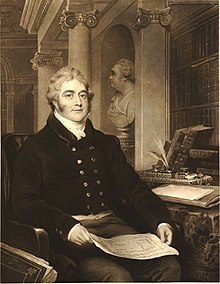|
Thomas Anson, 1st Earl of Lichfield
 Thomas William Anson, 1st Earl of Lichfield PC (20 October 1795 – 18 March 1854), known as Viscount Anson from 1818–31, was a British Whig politician from the Anson family. He served under Lord Grey and Lord Melbourne as Master of the Buckhounds between 1830 and 1834 and under Melbourne Postmaster General between 1835 and 1841. Lichfield's gambling and lavish entertaining got him heavily into debt and he was forced to sell off the entire contents of his Shugborough Hall estate. Early lifeAnson was the eldest son of Thomas Anson, 1st Viscount Anson, and his wife Anne Margaret, daughter of Thomas Coke, 1st Earl of Leicester. Major-General the Hon. George Anson was his younger brother. He was educated at Eton and Christ Church, Oxford.[1] CareerAnson was elected to the House of Commons for Great Yarmouth in June 1818, but had to resign the seat the following month on the death of his father and his succession to viscountcy of Anson.[2] Anson later served under Lord Grey and Lord Melbourne as Master of the Buckhounds from 1830 to 1834[3] and under Melbourne as Postmaster General from 1835 to 1841. He was admitted to the Privy Council in 1830[4] and in 1831 he was created Earl of Lichfield, of Lichfield in the County of Stafford, in William IV's coronation honours.[5] Military careerHe had joined the part-time Staffordshire Yeomanry as a trooper in 1811 before being appointed captain of the Lichfield Troop on 3 August 1812. He was promoted to major on 27 September 1819 and to lieutenant-colonel and second-in-command on 17 December 1829. The regiment provided the escort when the Duchess of Kent and her daughter Princess Victoria visited him at Shugborough in 1832. He succeeded as lieutenant-colonel commandant of the regiment on 10 April 1833 and commanded it until his death, having served more than 40 years, over 20 of them in command. After his death the regiment erected a memorial to him in Lichfield Cathedral.[6] GamblingAnson was also known for his excessive gambling and lavish entertaining at his Shugborough Hall seat. He also purchased the estate at nearby Ranton, Staffordshire, where he built Abbey House and developed the estate into a great sporting centre. However, his extravagant lifestyle and gambling put him and the family into debts of £600,000 and led to Anson's financial collapse in 1842. The entire contents of Shugborough Hall were sold off to pay for the debts.[7][8][9] Abbey House at Ranton burned down in 1942. The ivy-covered ruins can still be seen. Personal life Lord Lichfield married Louisa Catherine, daughter of Nathaniel Philips, in 1819. They had four sons and four daughters, being:[10]
Lord Lichfield died at his townhouse at 2 Stanhope Street in Mayfair,[1] aged 58, and is buried at St Michael and All Angels Church in Colwich, a short distance from Shugborough Hall.[10] He was succeeded in the earldom by his eldest son, Thomas. Lady Lichfield survived him by over 25 years and died in August 1879. See alsoReferences
External links |
||||||||||||||||||||||||||||||||||||||||||||||||||||||||
